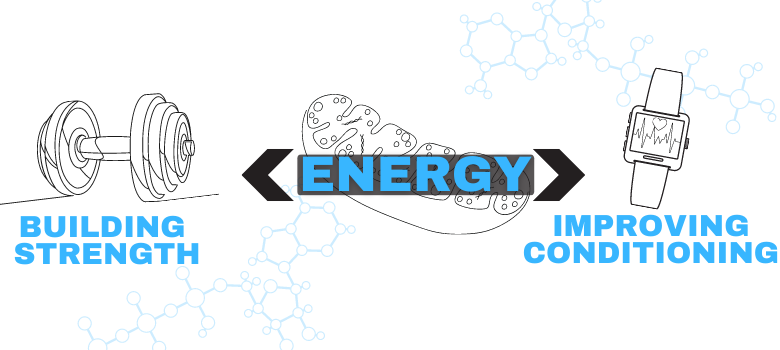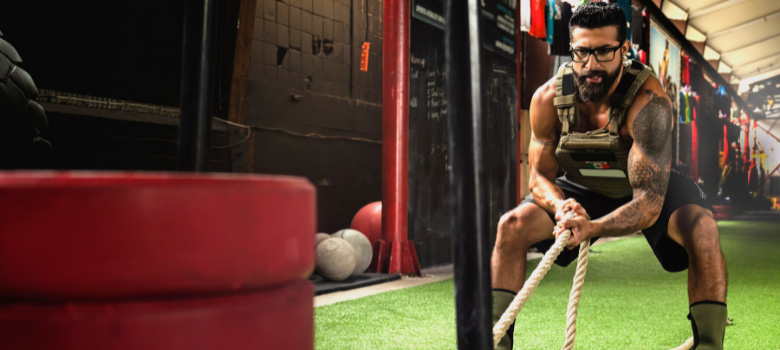
A recent meta-analysis by researchers in Japan (Momma et al 2021) showed just how important it is to include both strength and aerobic conditioning in your training program if your goal is the live the longest, healthiest life possible.
What their analysis of a group of studies found was:
- As little as 30 min/week of strength training was associated with a 10-20% lower risk of all-cause mortality. Also important to note was they found that more, was not better.
- Adding aerobic training was associated with a 40% lower risk – doubling the effect!
This isn’t a new idea.
People generally know there are benefits to both, but in the last few years, there’s been an unhelpful trend on social media to push the ideas that A) strength is all that’s really needed for health and longevity and B) adding any sort of conditioning to a strength program—particularly anything other than high intensity intervals—means you’re going to get weaker and lose muscle.
The truth is, when programmed intelligently, conditioning can actually improve strength and power gains.
This is because the aerobic engine is what drive recovery and recovery is ultimately what turns your training into fitness.
With that in mind, here are my top three rules for putting both of these important pieces of the fitness together in a way that makes them more effective together.
Rule #1: Always prioritize your training goals
In order to effectively combine strength with conditioning, you need to start by prioritizing your training from the start.
Unless you’re a beginner or coming back from a long break, it’s extremely difficult to improve both strength and conditioning at the same time.
When you design a program, start by asking yourself one fundamental question: “Do I want to prioritize improving strength OR building conditioning in this program?”
Both should be a part of it, but one must be the priority.
Trying to improve both at the same time is a recipe for poor results unless you’re starting from ground zero and where a lot of people go wrong.
There’s one simple reason for this: energy.
Since building bigger, stronger muscles is an intensive process, it takes a lot of energy for the body to repair, rebuild, and remodel tissues throughout the body.
Likewise with conditioning, improving the vascular network throughout the body and enabling it to deliver more oxygen to working muscles doesn’t happen without the body devoting a significant amount of resources to it.

Energy = The currency of the body
It takes a considerable amount of energy just to keep your body running, let alone build new muscle or other tissue. That’s why energy is often called the “currency” of the body: you have to spend it wisely since you can only produce so much in a given day.
Regardless of your goals, if you want to make progress, the most important thing is to choose how you want to spend your energy.
If you need to improve your aerobic conditioning, spend the majority of your time and energy doing just that, while only spending the minimum amount necessary to maintain strength and power.
If you’re trying to get bigger and stronger, the first rule means that you should only do the amount of conditioning work than it takes to avoid losing what you already have.
Doing more than that is not better and may very well be worse.
Here are a few simple guidelines to maintain conditioning while increasing strength and power
To avoid this common problem, conditioning work should be added to strength and power programs with the distinct goal of maintaining conditioning levels, rather than trying to improve them at the same time.
While there are a lot of different factors that determine exactly how much training you need in order to maintain a fitness quality once you’ve developed it, a good rule of thumb is that it takes at least 80% of the overall volume that you would need to use to improve it.
Here are some easy guidelines to start with:
- High level of conditioning: If you’re trying to maintain a high level of conditioning, you’ll likely need to include some form of conditioning work at least 4-5 days per week for 30-40 minutes.
- Moderate level of conditioning: If you’re only trying to maintain relatively moderate levels, 3-4 days per week for at least 30 minutes should do the job.
- Low level of conditioning: For low levels of conditioning, 3 days per week of 20-30 minutes should suffice to prevent it from getting any lower. If you’re starting with very low conditioning, however, you’re likely better off improving it up to at least a moderate level before focusing on strength and power.
An easy approach is to start with these guidelines and then adjust as necessary. If you notice yourself losing conditioning, for example, then increase the volume by 5-10% and monitor to make sure it’s enough to maintain.
If you’re unsure of how to monitor your conditioning, here’s an article to help you out.

Rule #2: Use Complementary Training Methods – don’t make your methods fight each other
The next most important element to effectively combine strength with conditioning work is to use methods that complement one another, rather than compete with one another.
Which conditioning method should I use with my strength program?
Choosing the right conditioning methods to use with a strength program doesn’t have to be complicated.
To understand how to choose the right conditioning methods, it’s important to understand where strength comes from in the first place.
Developing strength and power is the result of just four different primary factors:
- Improving CNS neural drive to the muscles to increase fiber recruitment.
- Building bigger muscles capable of more force production.
- Greater sympathetic nervous system activation causing higher levels of hormones to be released.
- Developing better technique.
Creating the right environment for all these things to happen means emphasizing quality over quantity (and emphasizing lifting heavy and explosively.)
Training methods like max effort, dynamic effort, and plyometrics are all designed to improve nervous system function, while the repetition method is often used as a supplement to help increase muscle size.
The thing to take note of is that all of these methods primarily rely on the anaerobic-alactic energy system to drive the majority of energy production during the work periods. Given their short, high-intensity nature, the alactic system is the only one capable of generating energy fast enough.
Because the alactic system can’t produce energy by itself for very long, however, it’s up to the aerobic system to clear out the byproducts of anaerobic metabolism and restock the substrates the alactic system needs so it can produce energy again.
This means that strength and power training is primarily driven by alactic-aerobic metabolism.
So when we choose conditioning methods to complement strength work, we need to use methods that largely fall into the same category, like:
- Tempo intervals
- Sled dragging
- GPP circuits
- Tempo lifting
- Explosive repeat
- Alactic/Green power intervals
- High intensity continuous training (HICT)
If you’re unfamiliar with these methods, you can find them in my 8-week Metamorphosis conditioning program and certification course.
If you’re using Morpheus (click here to learn more), you can program many of these directly into the interval builder to use your workouts.
All these conditioning methods use the same basic energy systems as strength and power training, which means they can be used to maintain aerobic fitness—without impairing strength and power gains.
When programmed in the right amounts, some of them will help improve strength and power gains by improving recovery through an increase in blood flow to fatigued muscles.
To understand how to do this properly, we have to talk about Rule #3

Rule #3: Organize your training effectively based on your fitness level
How you organize your training can have a substantial impact on the results that you see.
The reason for this comes back to what I talked about in the beginning: energy.
Combining different types of methods in the same workout, or in the same day, will impact how your body stores and utilizes energy, particularly glycogen. And research has shown it can influence the genetic signaling that takes place as a result of the workout.
It’s this signaling that stimulate changes in fitness, so it’s important to organize your training program in the most effective way possible.
The specifics of how to do this, once again, depend largely on where you’re starting, since that dictates how much conditioning work you’ll need to do and how your body responds to training in general.
- Low fitness level: If you’re starting with a lower level of fitness, you can combine conditioning within the strength workout, but it should be done at the end of the workout. Methods like tempo intervals, HICT, sled dragging, work particularly well here.
- Moderate fitness level: At moderate levels of fitness, conditioning should be separated into different workouts if possible, but they can be done on the same day. If scheduling permits, conditioning workouts can be performed 4-6 hours after the lifting session as this will help promote recovery. Use fairly heavily loaded exercises with concentric-only methods like sled dragging and High Intensity Continuous Training (HICT)
- High fitness level: To improve strength and power at the highest levels, it’s best to separate conditioning work and perform them on different days. This separation is important to prevent any negative interference and to maximize the effects of the heavy strength and power work. Using a high/low approach where strength above 90% of max and lower intensity conditioning work are done on alternating days throughout the week is an effective approach for most.
As you can see, the higher your levels of fitness, the more important it becomes to separate different types of training away from each other. This is because as your fitness improves, it requires more and more energy be devoted to both the training session and the recovery that takes place after.
There’s a big difference in how much training and energy it takes to increase your squat from 400-500 pounds compared to how much it takes to increase it from 200-300 pounds.
The further up the fitness chain you progress, the more important it becomes that as much of your energy as possible is focused on the specific demands of what you’re trying to improve.
This doesn’t mean your training needs to become entirely one-dimensional, however. It simply means that separating different types of training from one another becomes more important than ever—especially at the highest level.

Putting the pieces together
Regardless of what your specific fitness goals may be, there are benefits to including both strength and conditioning within your training program. Even if your primary goal is just to build a ton of strength, some metabolic conditioning is still important for overall health and to help speed up recovery.
And if your goal is to maximize your conditioning, strength plays an important role in this as well. It’s extremely rare where the right answer is to only include one form of training in your entire program.
Following the 3 rules I’ve laid out will help make sure that you’re getting the most out of each workout and building the right foundation for long-term results and success.
- Prioritize your training goals to ensure your body is spending energy where it’s needed most. It’s possible to maintain strength and power while boosting conditioning, just like it’s possible to maintain your conditioning while boosting your strength and power.
Unfortunately, too many people either try to improve both at the same time, or they focus on one and neglect the other.
- Use complementary training methods. Strength and power training is primarily driven by alactic-aerobic metabolism, which means the best conditioning methods to use are the ones that fall in the same category. (Like tempo intervals, sled dragging, GPP circuits, and more.)
- Work with your (or your client’s) fitness level. Combining different types of methods in the same workout, or in the same day, impacts how your body stores and utilizes energy. Depending on your fitness level, you’ll need to organize the training program in a way that allows full recovery.
Want a ready-made program? I recommend checking out Metamorphosis, my 8-week program designed to get you in the best conditioning shape of your life.
Bonus: join now and get an extra 4-weeks of programming for free! Learn More.

